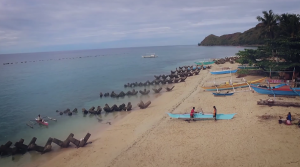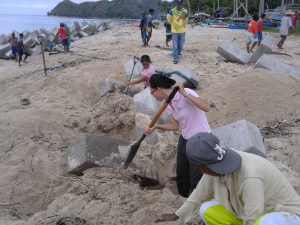
Mararison! The name itself conjures the image of things exotic and mysterious.
A small, hook-shaped island off Antique province, Mararison (or Malalison) has recently emerged as a tourist destination due to its picturesque mountain ridges, a mini-rainforest, a lustrous beach made of corals and refined white shells, and clear waters teeming with marine life, a magnet for divers.
But, only a few years ago, this island barangay, a part of Culasi town, was in danger of getting swallowed by the sea.
Since 2002, this beautiful white sand beach has been eroding. Little by little, the sea water has gnawed at the white sand and shifted some towards the middle of the island.
Despite the environmental degradation, however, the islanders were hardly bothered.
But things got worse in 2008 and 2013 when Typhoons Frank and Yolanda cut a wide swathe of destruction across major parts of the Visayas.
By then the residents felt the tremendous wrath of nature as the typhoons not only disconfigured the landscape but also their homes and barangay infrastructures.
Culasi Municipal Agriculture Officer Amancio Estolloso said more than 100 meters of white sand beach disappeared into the sea due to Yolanda. Along with it came the barangay plaza and classrooms of the Malalison Elementary School
Estolloso, who is at the same time the Kalahi-CIDSS vice-convenor, said households and structures, including the SEAFDEC station, located along the shores were destroyed.
Estolloso said residents now feared that more houses will disappear in the coming years. Residents living along the shoreline were forced to move to higher ground.
The school and barangay plaza were transferred to the hilly part of the island.
Not too long ago, the villagers waged a valiant effort against the constant erosion wrought by tidal action, the monsoon, and wave surges. They tried to build sea walls in their front yards. Their efforts proved puny against the forces of nature.
Typhoon Yolanda opened their eyes. The damage on Mararison’s storm-battered shoreline exposed the vulnerability of the community to coastal erosion and absence of appropriate infrastructure to address an environmental problem.
Thus, the residents presented the need for the construction of jackstone type coastal protection during the Municipal Inter-Barangay Forum (MIBF).
In 2014, Mararison’s construction of jackstone type coastal protection was prioritized for funding in the 2nd Cycle of Kalahi-CIDSS implementation.
The project was to be completed within 40 calendar days beginning November 2014. But it was finished more than a year later in 2016 because of some issues
The hauling of raw materials was difficult and costly. But this was expected. What was not anticipated was the dearth of workers. Community participation was a problem.
The reason? Tourism.
While Typhoon Yolanda did a lot of damage, photos of the island that were posted during relief operations drew a lot of attention to its beauty. It sparked tourism, both local and foreign. In 2015, the number of tourist arrivals drastically increased to unprecedented heights. And the trend continued until 2016. Thus, rather than work on the project, many residents would rather focus on earning a living through fishing and tourism.
Still, some of the community volunteers persisted in pushing the project not minding the difficulties. They applied the Community-Driven Development (CDD), as a process to get the project done.
 Volunteer Shiena Doroteo, whose house is one of the structures destroyed by Typhoon Frank, said she had been living on the island for 27 years. Throughout these years, many things have changed. Houses and other structures have disappeared. Even concrete structures were not spared.
Volunteer Shiena Doroteo, whose house is one of the structures destroyed by Typhoon Frank, said she had been living on the island for 27 years. Throughout these years, many things have changed. Houses and other structures have disappeared. Even concrete structures were not spared.
“Sa tuod rugya amon balay kadya pero sa mga bagyo nga nag-agi two hectares ginkaon pati amon balay nadula (Our house on this side, but when the typhoons came two hectares was swallowed and our house vanished).”
Doroteo said she volunteered in Kalahi-CIDSS because of the importance of the project in protecting the community. And she wants the younger generation to enjoy the white sand beach.
She recalled that there were times they have to leave the island even if it is raining hard just to attend Kalahi-CIDSS trainings in the town proper.
While Barangay Treasurer Jose Ajero said she is grateful that the proposed project was prioritized for funding since they were not prioritized in the 1st Cycle of implementation.
She added the barangay alone has no capacity to build and finance such project. The project cost P2.9 million for the 210 jackstone type coastal protection.
The persistence and dedication of the community volunteers paid off when the project was finally completed and installed in one portion of the island.
 Today, the white sand, broken corrals and shells slowly fill the island’s eroded portion. It becomes a playground for visiting tourists.
Today, the white sand, broken corrals and shells slowly fill the island’s eroded portion. It becomes a playground for visiting tourists.
The influx of tourists in the island provides the community an opportunity from making money aside from fishing.
This project has a huge impact in protecting the shoreline against erosion. If not for the white sand, tourists would not come here, said Estolloso.
He explained that the jackstone also protected the marine sanctuary in the island. The jackstone prevented the sand from being swept by the sea. The sanctuary is home to a number of fish species such as grouper and butterfly fish.
While the island is still recovering from its coastal erosion, the local government unit is proposing to abate human activities such as prohibiting the construction of concrete structures and exercise proper waste disposal in the island. # (MMC/Kalahi-CIDSS/DSWD)
